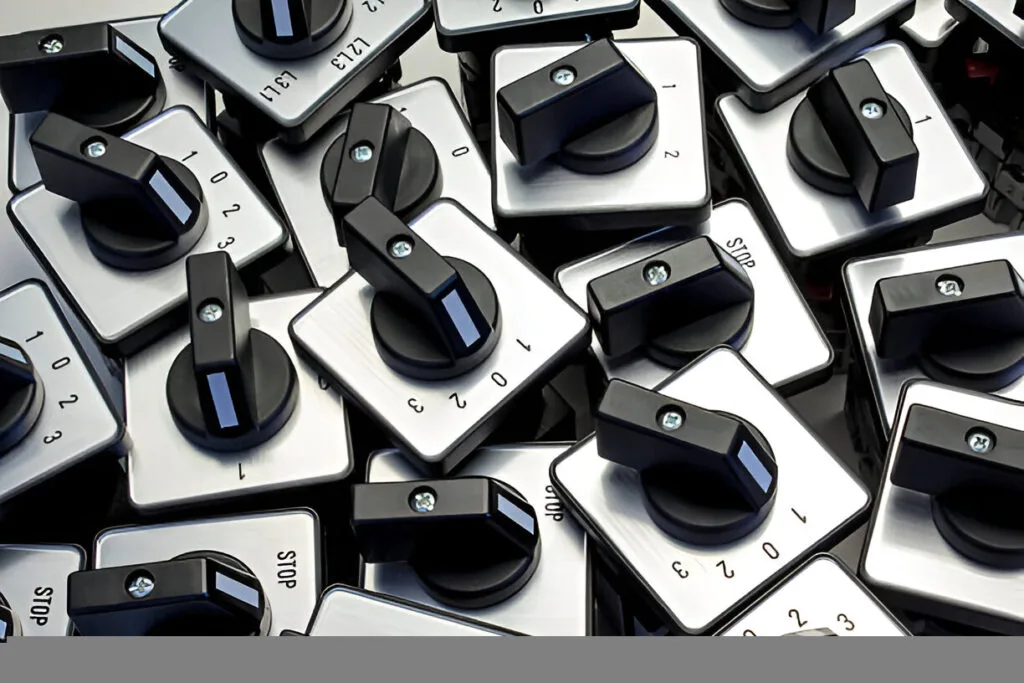The Selector Switch 3 Position is a vital control device in industrial automation, machinery, and building management.
Its ability to offer three distinct operational states through a single interface makes it a preferred choice for engineers, panel builders, and automation professionals.
This article will explain what a three position selector switch is, how it works, its symbol in circuit diagrams, and its main applications.
What is a Selector Switch 3 Position?
A Selector Switch 3 Position is an electromechanical device that allows users to select between three different circuits or operational modes by turning a knob or lever. Commonly, the three positions are labeled as “Manual,” “Off,” and “Auto,” or simply as “1,” “0,” and “2.” Unlike push-buttons, which are pressed, a selector switch is rotated to open or close contacts within the contact block.
Selector switches are available in several types, including short handle, long handle, key-operated, illuminated, and non-illuminated versions, each suited for specific environments and requirements. The 3 position rotary selector switch is especially popular for its clear tactile feedback and robust construction.
How Does a 3 Position Selector Switch Work?
The operation of a 3 position selector switch is based on a combination of mechanical movement and electrical switching:
Mechanical Construction
- Internally, the switch contains a rotor or cam that aligns with stationary contacts as the knob is turned.
- Each position engages a specific set of contacts, ensuring only one circuit is active at a time, which enhances safety and prevents conflicts.
Switching Mechanism
- Turning the knob to each position (left, center, right) closes or opens different contacts.
- For example, in the “Manual” position, the manual circuit is closed; in “Off,” all circuits are open; in “Auto,” the automatic circuit is closed.
Momentary vs. Maintained Action
- Some selector switches are maintained (stay in position until turned), while others are momentary (spring return to center after release).
- Momentary switches are often used for temporary actions, such as starting a motor for a short period.
Applications of Three Position Selector Switches
The selector switch 3 position is widely used across industries due to its flexibility and reliability:
- Industrial Machinery: Switching between manual, off, and automatic modes for motors or pumps.
- Control Panels: Selecting operational modes or functions in complex systems.
- Automotive: Managing multiple functions in commercial vehicles.
- Building Automation: Controlling lighting, HVAC, or other building systems.
- Medical Equipment: Selecting operational settings in diagnostic or treatment devices.
- Public Infrastructure: Managing lighting or systems in parks and public buildings.


How to Wire a 3 Position Selector Switch
Wiring a 3 position rotary selector switch is straightforward but must be done correctly for safety and function:
- Identify the common terminal and the terminals for each position.
- Refer to the manufacturer’s wiring diagram to ensure correct connections.
- Connect the power supply to the common terminal.
- Wire each output device (e.g., motor, lamp) to the corresponding position terminal.
- Test each position to confirm the correct circuit is activated.
Conclusion
The Selector Switch 3 Position is an essential component for modern control systems, offering flexibility, reliability, and easy operation.
Its intuitive design and clear schematic symbols make it a staple in industrial automation, building management, and many other fields.
FAQs
Can a 3 position selector switch be used for both AC and DC circuits?
Yes, but always check the manufacturer’s specifications for voltage and current ratings.
How do I wire a 3 position rotary selector switch?
Identify terminals, follow the wiring diagram, connect the common and position terminals, and test each position for proper operation.
What is the difference between a maintained and momentary 3 position selector switch?
Maintained switches stay in the chosen position until manually changed, while momentary switches return to a default position after release.

